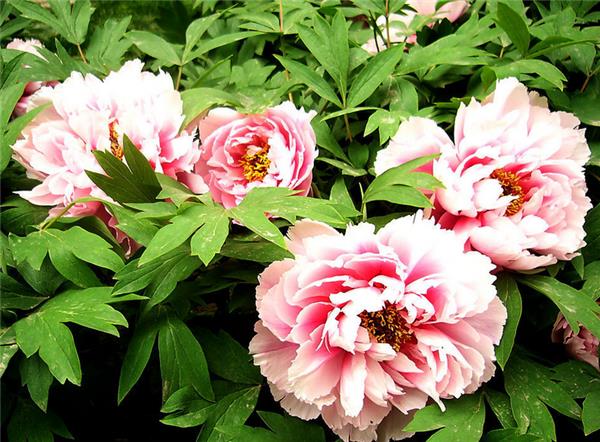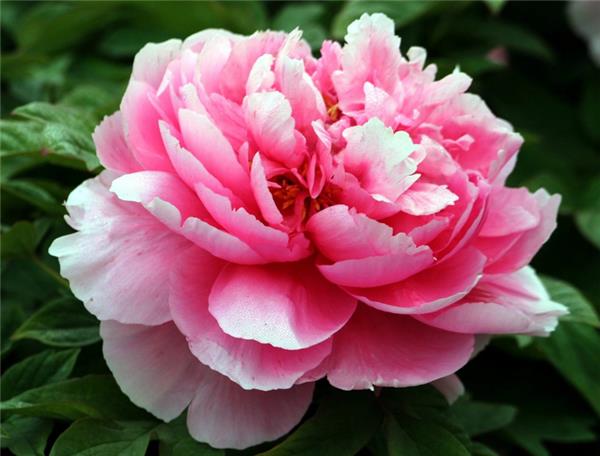Planting technique of peony flower
Peony flower color is beautiful, jade smile pearl fragrance, elegant and unrestrained, magnificent, known as "king of flowers" reputation, the following to share with you is the peony planting technology.

Planting technique of peony flower
Peony planting should choose loose, fertile, well-drained sandy soil, planted in the leeward to the sun, not easy to accumulate water. It is generally planted from late September to early October. The suitable planting depth is the soil surface at the junction of root and stem, and the size of the planting pit is that the root can be extended, and some fine soil is left in the pit to form a small pier to make the root sit on the soil, straighten out the root system, then restore the soil, stabilize the soil, irrigate two or three times of water, and the suitable row spacing is 50X50 (cm).

Seed propagation and plant division propagation were used.
The main results are as follows: (1) seed propagation: the propagation coefficient is large, but the seedling formation time is long, so it can not maintain the good characters of the parents.
① seedlings: peony seeds can be treated with 1% gibberellin for 48 hours, or a low temperature of about 5 ℃ can release Hypocotyl dormancy, and seedlings will be unearthed in the following spring after sowing. Strip sowing according to the row spacing of 20 meters, plant spacing of 6 meters, covering soil of about 3 meters, border cover grass.
② transplanting: after two years of sowing, the seedlings should be raised, and the diseased and weak plants, especially those with root-knot nematodes, should be firmly removed. The seedlings are divided into two grades according to their size. Each seedling requires 3 to 4 branches. The excessively long roots are properly cut to the depth of the hole. The seedlings are planted according to the row spacing of 30 cm. There are 2 plants in each hole, and the roots must be extended. The top bud is covered with soil about 3 cm.
③ direct seeding: seedling transplanting is generally used in production, but in recent years, direct seeding is used in some places, and the row spacing is the same as that of seedling transplanting. The advantage of direct seeding is that the rhizome is long and straight, so a better yield can be obtained.

(2) ramet propagation: the four-to five-year-old strong mother plant was dug up at harvest, cut off the large and middle roots and put into medicine, cut off from the place where it was easy to split into 2-4 plants, and could be transplanted from September to November. Early planting was better. Before planting, the soil was turned 60 cm deep, 90,000 kg of basic fertilizer was applied per hectare, ditched and divided into borders, the plant row spacing was 25 m × 35 m, 1 plant was planted obliquely in each hole, and the soil was covered with 3 × 4 m.
(3) grafting: this method can maintain the excellent characters of the mother plant, but the reproduction coefficient is small. In autumn, the rootstock of 5 ~ 6 years old was selected, which was 15 cm long and 2 cm in diameter. The rootstock was dug out and placed in a cool place for 2 ~ 3 days, softened and used. The scion should take the current year's branches with full growth, smooth and short internodes, with 1 or 2 full buds. After the rootstock is closed with the scion cambium, it is bound with hemp bark and other things.

Administration and Management
(1) Intermediate ploughing and weeding: after the beginning of spring, it is combined with weeding several times to prevent root injury and cultivate soil in winter, which is beneficial to root growth.
(2) fertilization: it is necessary to apply enough stable manure or manure when transplanting, and it is more important to apply fertilizer in autumn. Generally, 6000 kg of manure and 1500 kg of rapeseed cake fertilizer are applied per hectare, and the leaves should be prevented from being fouled when applying fertilizer.
(3) picking flowers: every spring, the buds will be picked immediately after budding. Except for special uses such as keeping seeds and selling flowers.
(4) shaping and pruning: including setting drying, removing soil buds and picking buds.
Note: peony is cold-resistant and not resistant to high temperature. In both eastern and central China, the flower buds began to expand gradually when the winter temperature reached 4 ℃. The suitable temperature is 16-20 ℃, and it will not blossom below 16 ℃. At high temperatures in summer, plants are semi-dormant.
Related
- Wuhan Hospital Iron Tree Blooming Result Was Instantly Frightened by the Gardener Master
- Which variety of camellia is the most fragrant and best? Which one do you like best?
- What is the small blue coat, the breeding methods and matters needing attention of the succulent plant
- Dormancy time and maintenance management of succulent plants during dormancy
- Minas succulent how to raise, Minas succulent plant pictures
- What are the varieties of winter succulent plants
- How to raise succulent plants in twelve rolls? let's take a look at some experience of breeding twelve rolls.
- Attention should be paid to water control for succulent plants during dormant period (winter and summer)
- Watering experience of twelve rolls of succulent plants
- Techniques for fertilizing succulent plants. An article will let you know how to fertilize succulent plants.



